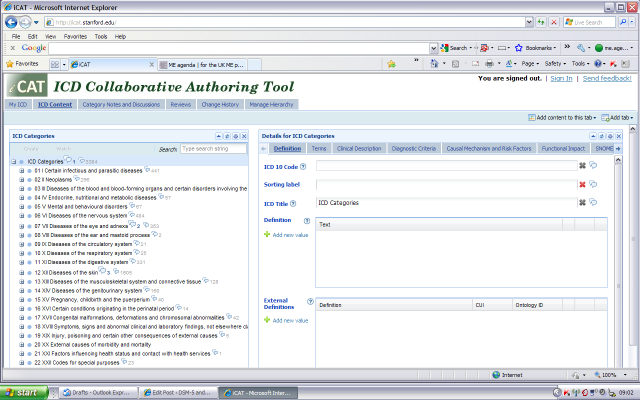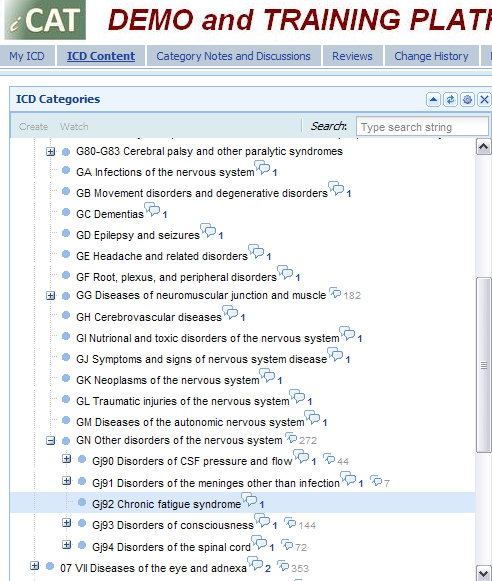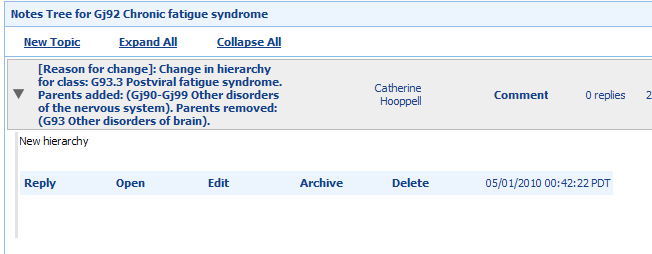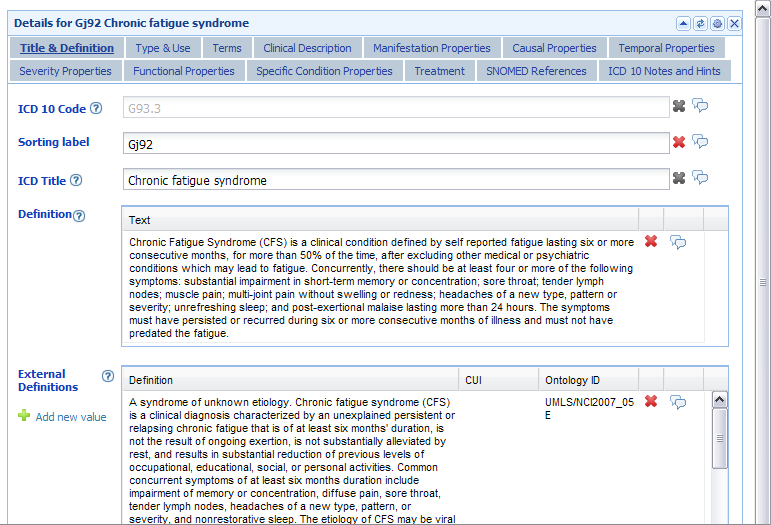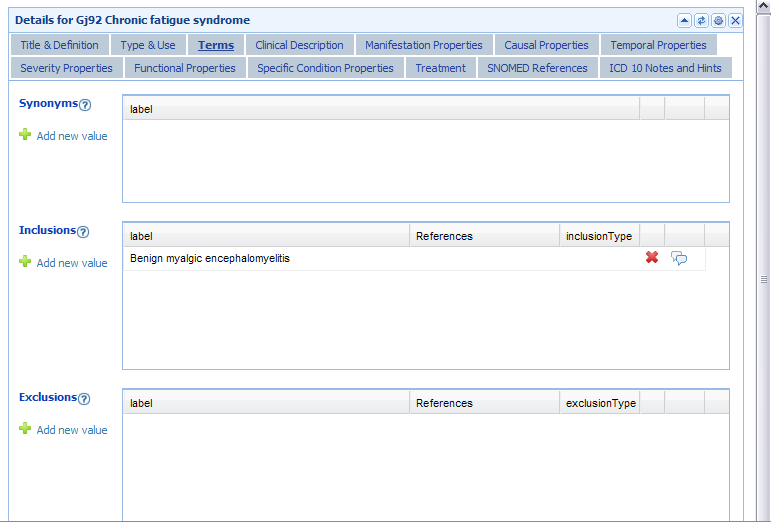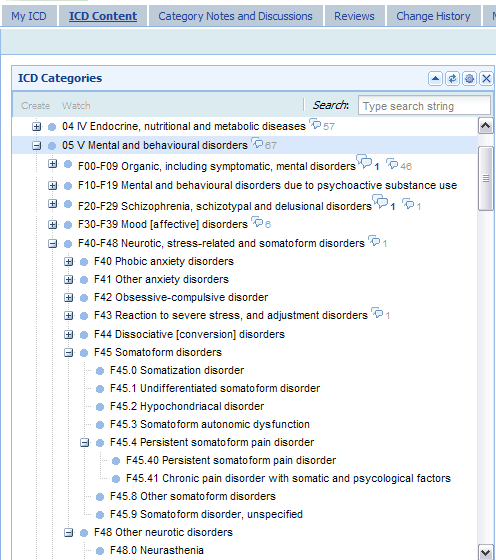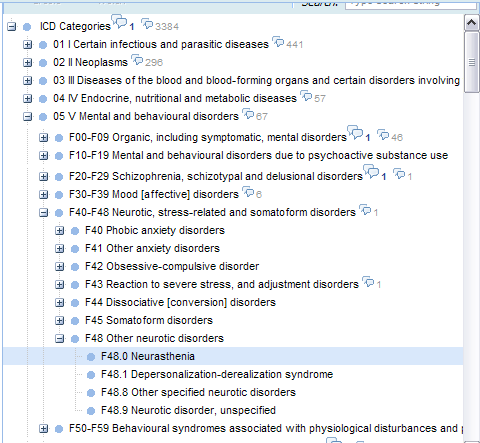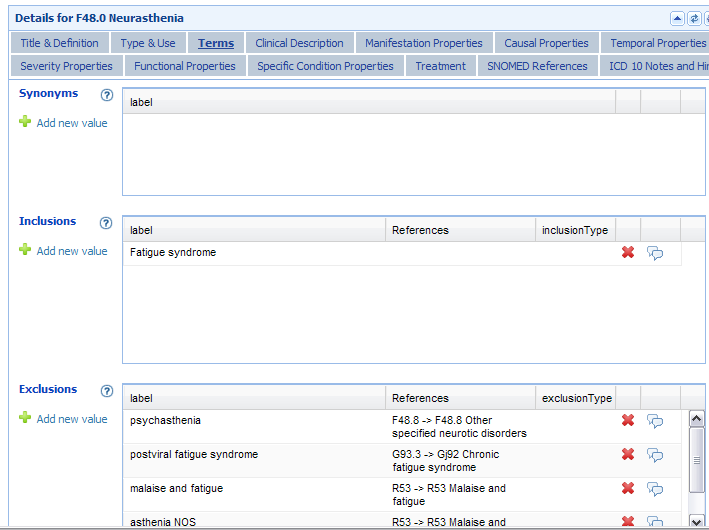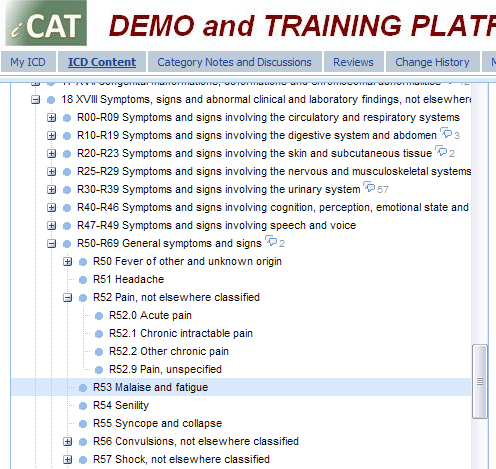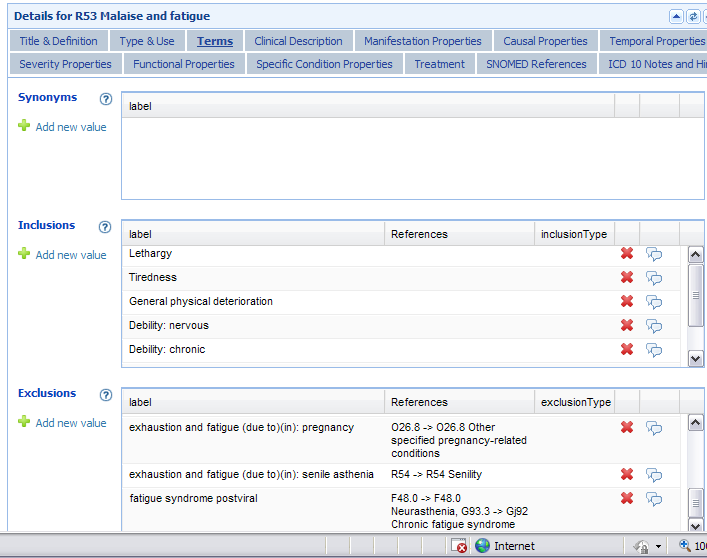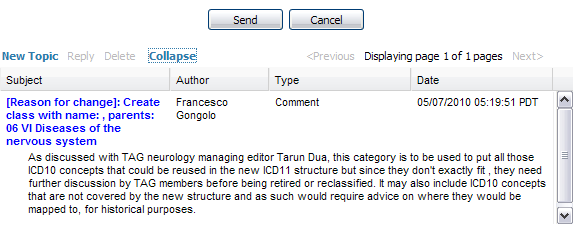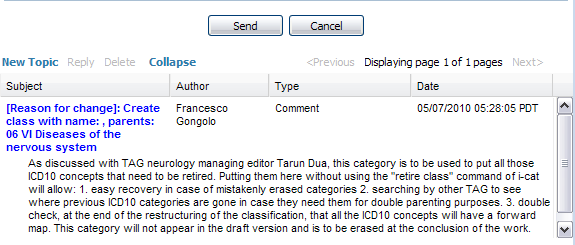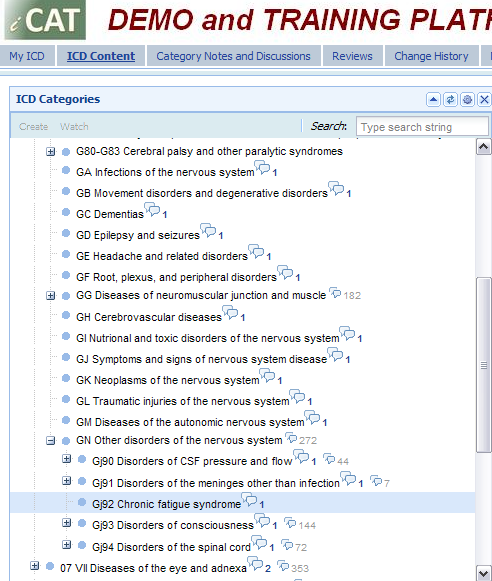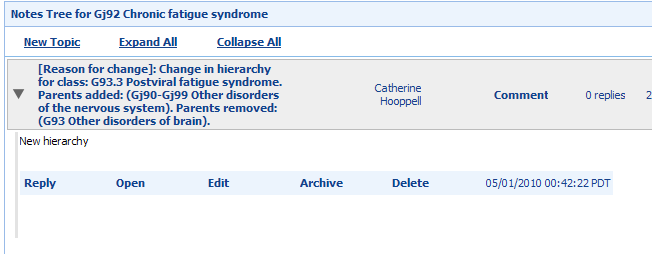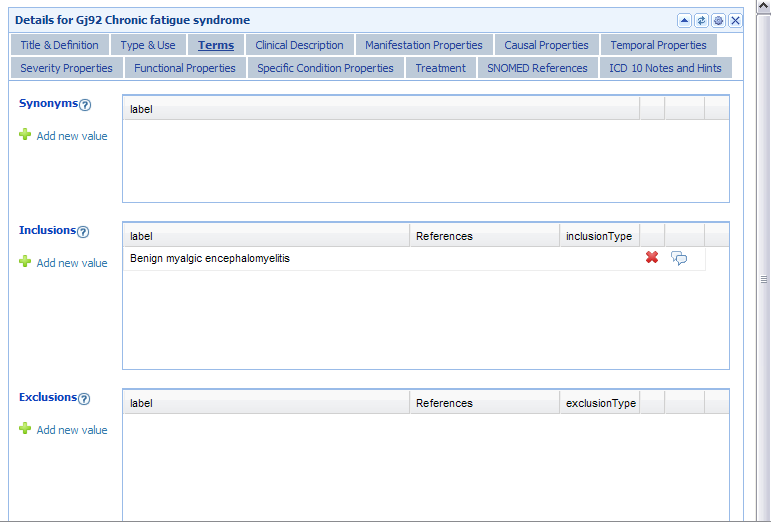Dx Revision Watch
Suzy Chapman Owner of Dx Revision Watch
- Messages
- 3,061
- Location
- UK
ETA: Please see Posts # 5, 6, 7 and 8 for most most recent information @ 10 June 2010
A version of this report will also be published on Co-Cure mailing list and Dx Revision Watch site.
6 May 2010
Note that information in this report applies to the revision of ICD-10 towards ICD-11. Countries using a "Clinical Modification" of ICD, for example, Canada (ICD-10-CA), the USA (implementing ICD-10-CM, in October 2013), Australia (ICD-10 AM) and Germany (ICD-10-GM) should refer to their own national modifications of ICD.
Information on the launch of ICD-11 Alpha Draft
The revision of ICD-10 is overseen by a Revision Steering Group (RSG) and is being undertaken by a number of Topic Advisory Groups (TAGs) via a collaborative authoring platform called the iCAT (Initial ICD-11 Collaborative Authoring Tool) using wiki like software.
Topic Advisory Groups have responsibility for revision of the various chapters, formulating definitions and diagnostic criteria for the relevant categories and suggesting changes to the classification structure.
Since 2007, anyone has been able to submit proposals to the various Topic Advisory Groups for changes or additions to ICD-10 via the ICD Update and Revision Platform. This is not the iCAT, but an extranet where any registered user has been able to submit proposals backed up with citations.
You can register for access, here:
https://extranet.who.int/icdrevision/nr/login.aspx?ReturnUrl=/icdrevision/default.aspx
The WHO has scheduled a press launch of the ICD-11 Alpha Draft and the iCAT electronic authoring platform between 10 - 17 May.
You can see how the iCAT operates in this series of ICD Revision YouTubes: http://wp.me/PKrrB-eV
Once launched, the iCAT will be viewable to anyone who registers for access. But there will be varying levels of editing authority which will initially be restricted to WHO Classification Experts, WHO Secretariat, ICD-11 Revision Steering Group, the Managing Editors and members of Topic Advisory Groups and working groups and the reviewers and expert advisers recruited by the TAG Managing Editors to assist with the reviewing of content.
There is also an iCAT User Group for which anyone can register for membership.
It is anticipated that the public will not be able to interact with the iCAT, for example to add comment on proposals, until after the Beta Draft has been released for public review and consultation. But following the launch, it should be possible to monitor the progress and population of content.
I have requested clarification of whether the names of external reviewers recruited by TAG Managers will be identified within the iCAT and whether the public will be able to track reviewers' input and comments as content proposals progress through the Alpha Drafting Workflow.
ICD Revision maintains a Google website here: https://sites.google.com/site/icd11revision/home
This site publishes agendas and minutes for ICD Revision meetings and also PowerPoint presentations and revision documents. Some of these documents are works in progress and revised versions are uploaded from time to time on this page and on the Face-to Face Meetings pages:
https://sites.google.com/site/icd11revision/home/face-to-face-meetings/icamp/documents
https://sites.google.com/site/icd11revision/home/face-to-face-meetings
There are links for several key documents in Footnotes [1].
The WHO publishes only ICD-10 Volume 1: The Tabular List and ICD-10 Volume 2: The Instruction Manual, online. Summaries of WHO meetings in 2007 and presentations in 2008 proposed that all three volumes of ICD-11 should be freely accessible via the internet. When ICD-11 is disseminated (2014+), all volumes, including Volume 3: The Alphabetical Index, will be electronically published and accessible online.
In ICD-10 Volume 1: The Tabular List, "Postviral fatigue syndrome" is classified in Chapter VI (6) Diseases of the nervous system under G93 Other disorders of brain, coded G93.3.
"Benign myalgic encephalomyeltis" is also coded G93.3.
http://apps.who.int/classifications/apps/icd/icd10online/?gg90.htm+g933
http://dxrevisionwatch.wordpress.com/icd-11-me-cfs/
In ICD-10, "Chronic fatigue syndrome" is listed in Volume 3: The Alphabetical Index, only, where it is indexed to G93.3.
To date, ICD Revision has been silent around the inclusion (or not) of "Chronic fatigue syndrome" in Volume 1: The Tabular List, in ICD-11.
Nor has ICD Revision published any intention that it proposes to revise the existing Index code for "Chronic fatigue syndrome" for ICD-11 or that "Chronic fatigue syndrome" should be placed in a chapter other than Chapter VI (6), to which it is currently indexed, if it were the case that ICD Revision is considering the inclusion of "Chronic fatigue syndrome" in Volume 1: The Tabular List.
My websites and reports make no assumptions about what proposals might be made by any of the Topic Advisory Groups for the potential inclusion of "Chronic fatigue syndrome" in Volume 1, in ICD-11. But since all three volumes of ICD-11 will be integrable, it is reasonable to anticipate that "Chronic fatigue syndrome" might be included in Volume 1 in this forthcoming edition. (See Footnote [2])
ICD-11 will drop the use of Roman numerals for chapter numbering, so we shall be monitoring, for example, the development of Chapter 5: Mental and behavioural disorders (TAGMH) and Chapter 6: Diseases of the nervous system (TAG Neurology).
The "Start-up List"
The starting point for the Alpha Draft is the "Start-Up List" of categories that has been drafted by WHO to initiate the editing process. This list includes current ICD-10 content, input from ICD national modifications, primary care versions and speciality adaptations, textual definitions imported from affiliate classification publications, proposals received to revise the existing ICD via the Update and Revision Platform and other channels.
During alpha drafting, detailed structured definitions will be added to these ICD categories according to a common template - the "Content Model".
The Content Model
According to ICD Revision, the most important difference between ICD-10 and ICD-11 will be the "Content Model".
The Content Model is designed to support detailed descriptions of the clinical characteristics of each category and clear relationships to other terminologies and classifications. It identifies the basic characteristics needed to define any ICD category through use of multiple parameters (eg Body Systems, Body Parts, Signs and Symptoms, Diagnostic Findings, Causal Agents, Mechanisms, Temporal Patterns, Severity, Functional Impact, Treatment interventions, Diagnostic Rules).
So there is the potential for considerably more content to be included for diseases, disorders and syndromes for any given entity in ICD-11 than currently appears in ICD-10.
There are examples of several disease entities populated in accordance with the Content Model on the ICD Revision website. The most recent version of the Content Model can be downloaded from this page:
https://sites.google.com/site/icd11revision/home/face-to-face-meetings/icamp2-2010/documents
or open the file here:
Word Document: Doc2b
Content Model Specifications and User Guide
http://tinyurl.com/ICD11ContentModelApril10
See also this paper:
"A Content Model for the ICD-11 Revision"
http://bmir.stanford.edu/file_asset/index.php/1522/BMIR-2010-1405.pdf
How advanced will the Alpha Draft be when it is launched?
According to this late 2009 document: http://tinyurl.com/SummaryiCAMPSept09
It was projected that
The most recent iCamp2 (2010) and Revision Steering Group Meetings took place on 19-23 April, in Geneva. The agenda is available here: http://tinyurl.com/AgendaiCAMP2April10
Revising ICD via the iCAT platform towards a publication comprising three integrable volumes capable of continuous revision in response to new scientific evidence is an ambitious and technically complex operation. ICD-11 is being authored collaboratively by Topic Advisory Group Managers, members and reviewers who are scattered all over the world and who are undertaking these roles in addition to their professional commitments. At present, 136 scientists from 36 countries and all WHO regions are contributing to the work. The Minutes of the April RSG meeting are not yet available and it's not clear how on target the Alpha Draft remains or whether the goals for May 2010 have had to be revised.
To view the iCAT Demo and training platform:
Go to the ICD-11 Revision site:
https://sites.google.com/site/icd11revision/home/
then to this page:
iCAT - Initial ICD-11 Collaborative Authoring Tool
https://sites.google.com/site/icd11revision/home/icat
and click on this link:
The demo and training iCAT platform: http://icatdemo.stanford.edu/
this will link to the server hosting the iCAT Demo and Training Platform where you can see how the iCAT will function. (Give it a little time to load.)
Once you are into the iCAT demo, you can poke about:
Click on the "ICD Content" Tab (second Tab on left)
Open the + next to "ICD Categories" if the drop down list is not already displaying
Open the + next to 06 VI Diseases of the nervous system
Open the + next to G90-G99 Other disorders of the nervous system
Open the + next to G93 Other disorders of brain
Click on G93.3 Postviral fatigue syndrome
On the Right of your screen:
Click on the "Definition" Tab if it is not already selected
You should see the following:
ICD Code* G93.3
ICD Title Postviral fatigue syndrome
Definition (Text currently unpopulated)
*For a Glossary of Terms click on the ? next to the Field Titles which link to a general page setting out the terms and template for content population within ICD-11.
(URL for this Glossary page is: http://apps.who.int/classifications/apps/icd/icatfiles/iCAT_Glossary.html#definition )
There are no Definitions populated in this demo for the entry for "Postviral fatigue syndrome".
Note that until the actual ICD-11 Alpha Draft is released, it cannot be determined how far the various Topic Advisory Groups have progressed with populating content according to the ICD Content Model for the categories of interest to us.
Some "External definitions" have been entered into the demo.
Note these have been imported from other classification systems, either as part of the initial "Start-up List", used to kick start the revision process, or are being used as examples of a populated field.
Again, we need to wait until the draft comes out to see how many fields have been populated so far, their textual content, and the editing status of their content.
External definitions:
Three definitions are currently displaying. (These three definitions are collated on this site along with their sources):
http://www.fpnotebook.com/Rheum/Sx/ChrncFtgSyndrm.htm
Very few Tabs have been populated in this demo version of the iCAT
Terms
Synomyms: Not yet populated
Inclusions: Benign myalgic encephalomyeltis
Exclusions: Not yet populated
Clinical Description; Body System; Body Part not yet populated
Entire brain (body structure) Term ID 258335003
Brain structure (body structure) Term ID 12738006
Diagnostic Criteria; Causal Mechanism and Risk Factors not yet populated
Causal Mechanism Virus (organism) Term ID 49872002
Risk Factors; Genomic Linkages; Etiology Type; Causal Mechanism; Functional Impact; SNOMED References not yet populated etc.
-------------------------
Go back to the ICD Content Tab list and open the page for Chapter 5 (V) Mental and behavioural disorders.
Then open the + for F40-F48 Neurotic, stress-related and somatoform disorders
Then open "F45 Somatoform disorders"
where the existing categories in ICD-10 Chapter V: Somatoform disorders are listed.
Note they are listed as they currently appear in ICD-10, as set out in this Comparison Table:
http://dxrevisionwatch.files.wordpress.com/2010/01/dsm-icd-equiv3.png
and are not congruent with any current proposals by the DSM-5 Work Group for Somatic Symptoms Disorders for the proposed major restructuring of the "Somatoform Disorders" categories, as published in the DSM-5 draft proposals for diagostic criteria, on 10 February:
http://www.dsm5.org/ProposedRevisions/Pages/SomatoformDisorders.aspx
"Harmonization" and integration of ICD-11 with DSM-5
There is already a degree of correspondence between DSM-IV and Chapter V of ICD-10. For the next editions, the APA and the WHO have committed as far as possible: "To facilitate the achievement of the highest possible extent of uniformity and harmonization between ICD-11 mental and behavioural disorders and DSM-V disorders and their diagnostic criteria" with the objective that "The WHO and APA should make all attempts to ensure that in their core versions, the category names, glossary descriptions and criteria are identical for ICD and DSM."
It should be evident from the iCAT demo that there is the potential for considerably more content to be included in ICD-11 than there is in ICD-10 and that the progress of the population of content for the categories of interest to us is going to need continuous monitoring as the Topic Advisory Groups and their reviewers work towards the Beta Draft.
I shall update when further information on the launch of the alpha and iCAT becomes available over the next couple of weeks.
-------------------------
Footnotes:
[1] Key documents:
Content Model Specifications and User Guide (v April 10)
Identifies the basic properties needed to define any ICD concept (unit, entity or category) through the use of multiple parameters.
http://tinyurl.com/ICD11ContentModelApril10
ICD-11 Revision Project Plan - Draft 2.0 (v March 10)
Describes the ICD revision process as an overall project plan in terms of goals, key streams of work, activities, products, and key participants.
http://www.who.int/classifications/icd/ICDRevisionProjectPlan_March2010.pdf
Alpha Drafting Workflow (v 06.10.09)
Sets out lines of responsibility between the various contributors for the alpha drafting phase.
http://dxrevisionwatch.files.wordpress.com/2010/01/alpha-drafting-workflow-27-01-10.doc
Further documents eg Style Guide, ICD-11 Conventions:
https://sites.google.com/site/icd11revision/home/face-to-face-meetings/icamp/documents
[2] The Introduction to ICD-10 Volume 3: The Alphabetical Index lists several possible relationships between a term included in the Alphabetical Index and a term included in the Tabular List to which it is indexed:
and, according to a February 2009 response from WHO HQ Classifications, Terminology and Standards Team, terms that are listed in the Index may be:
In indexing "Chronic fatigue syndrome" to G93.3, ICD-10 does not specify how it views the term in relation to "Postviral fatigue syndrome" or in relation to "Benign myalgic encephalomyelitis". Nor does ICD-10 specify how it views the relationship between "Postviral fatigue syndrome" and "Benign myalgic encephalomyelitis".
Suzy Chapman for Dx Revision Watch | 06.05.10
A version of this report will also be published on Co-Cure mailing list and Dx Revision Watch site.
6 May 2010
Note that information in this report applies to the revision of ICD-10 towards ICD-11. Countries using a "Clinical Modification" of ICD, for example, Canada (ICD-10-CA), the USA (implementing ICD-10-CM, in October 2013), Australia (ICD-10 AM) and Germany (ICD-10-GM) should refer to their own national modifications of ICD.
Information on the launch of ICD-11 Alpha Draft
The revision of ICD-10 is overseen by a Revision Steering Group (RSG) and is being undertaken by a number of Topic Advisory Groups (TAGs) via a collaborative authoring platform called the iCAT (Initial ICD-11 Collaborative Authoring Tool) using wiki like software.
Topic Advisory Groups have responsibility for revision of the various chapters, formulating definitions and diagnostic criteria for the relevant categories and suggesting changes to the classification structure.
Since 2007, anyone has been able to submit proposals to the various Topic Advisory Groups for changes or additions to ICD-10 via the ICD Update and Revision Platform. This is not the iCAT, but an extranet where any registered user has been able to submit proposals backed up with citations.
You can register for access, here:
https://extranet.who.int/icdrevision/nr/login.aspx?ReturnUrl=/icdrevision/default.aspx
The WHO has scheduled a press launch of the ICD-11 Alpha Draft and the iCAT electronic authoring platform between 10 - 17 May.
You can see how the iCAT operates in this series of ICD Revision YouTubes: http://wp.me/PKrrB-eV
Once launched, the iCAT will be viewable to anyone who registers for access. But there will be varying levels of editing authority which will initially be restricted to WHO Classification Experts, WHO Secretariat, ICD-11 Revision Steering Group, the Managing Editors and members of Topic Advisory Groups and working groups and the reviewers and expert advisers recruited by the TAG Managing Editors to assist with the reviewing of content.
There is also an iCAT User Group for which anyone can register for membership.
It is anticipated that the public will not be able to interact with the iCAT, for example to add comment on proposals, until after the Beta Draft has been released for public review and consultation. But following the launch, it should be possible to monitor the progress and population of content.
I have requested clarification of whether the names of external reviewers recruited by TAG Managers will be identified within the iCAT and whether the public will be able to track reviewers' input and comments as content proposals progress through the Alpha Drafting Workflow.
ICD Revision maintains a Google website here: https://sites.google.com/site/icd11revision/home
This site publishes agendas and minutes for ICD Revision meetings and also PowerPoint presentations and revision documents. Some of these documents are works in progress and revised versions are uploaded from time to time on this page and on the Face-to Face Meetings pages:
https://sites.google.com/site/icd11revision/home/face-to-face-meetings/icamp/documents
https://sites.google.com/site/icd11revision/home/face-to-face-meetings
There are links for several key documents in Footnotes [1].
The WHO publishes only ICD-10 Volume 1: The Tabular List and ICD-10 Volume 2: The Instruction Manual, online. Summaries of WHO meetings in 2007 and presentations in 2008 proposed that all three volumes of ICD-11 should be freely accessible via the internet. When ICD-11 is disseminated (2014+), all volumes, including Volume 3: The Alphabetical Index, will be electronically published and accessible online.
In ICD-10 Volume 1: The Tabular List, "Postviral fatigue syndrome" is classified in Chapter VI (6) Diseases of the nervous system under G93 Other disorders of brain, coded G93.3.
"Benign myalgic encephalomyeltis" is also coded G93.3.
http://apps.who.int/classifications/apps/icd/icd10online/?gg90.htm+g933
http://dxrevisionwatch.wordpress.com/icd-11-me-cfs/
In ICD-10, "Chronic fatigue syndrome" is listed in Volume 3: The Alphabetical Index, only, where it is indexed to G93.3.
To date, ICD Revision has been silent around the inclusion (or not) of "Chronic fatigue syndrome" in Volume 1: The Tabular List, in ICD-11.
Nor has ICD Revision published any intention that it proposes to revise the existing Index code for "Chronic fatigue syndrome" for ICD-11 or that "Chronic fatigue syndrome" should be placed in a chapter other than Chapter VI (6), to which it is currently indexed, if it were the case that ICD Revision is considering the inclusion of "Chronic fatigue syndrome" in Volume 1: The Tabular List.
My websites and reports make no assumptions about what proposals might be made by any of the Topic Advisory Groups for the potential inclusion of "Chronic fatigue syndrome" in Volume 1, in ICD-11. But since all three volumes of ICD-11 will be integrable, it is reasonable to anticipate that "Chronic fatigue syndrome" might be included in Volume 1 in this forthcoming edition. (See Footnote [2])
ICD-11 will drop the use of Roman numerals for chapter numbering, so we shall be monitoring, for example, the development of Chapter 5: Mental and behavioural disorders (TAGMH) and Chapter 6: Diseases of the nervous system (TAG Neurology).
The "Start-up List"
The starting point for the Alpha Draft is the "Start-Up List" of categories that has been drafted by WHO to initiate the editing process. This list includes current ICD-10 content, input from ICD national modifications, primary care versions and speciality adaptations, textual definitions imported from affiliate classification publications, proposals received to revise the existing ICD via the Update and Revision Platform and other channels.
During alpha drafting, detailed structured definitions will be added to these ICD categories according to a common template - the "Content Model".
The Content Model
According to ICD Revision, the most important difference between ICD-10 and ICD-11 will be the "Content Model".
The Content Model is designed to support detailed descriptions of the clinical characteristics of each category and clear relationships to other terminologies and classifications. It identifies the basic characteristics needed to define any ICD category through use of multiple parameters (eg Body Systems, Body Parts, Signs and Symptoms, Diagnostic Findings, Causal Agents, Mechanisms, Temporal Patterns, Severity, Functional Impact, Treatment interventions, Diagnostic Rules).
So there is the potential for considerably more content to be included for diseases, disorders and syndromes for any given entity in ICD-11 than currently appears in ICD-10.
There are examples of several disease entities populated in accordance with the Content Model on the ICD Revision website. The most recent version of the Content Model can be downloaded from this page:
https://sites.google.com/site/icd11revision/home/face-to-face-meetings/icamp2-2010/documents
or open the file here:
Word Document: Doc2b
Content Model Specifications and User Guide
http://tinyurl.com/ICD11ContentModelApril10
See also this paper:
"A Content Model for the ICD-11 Revision"
http://bmir.stanford.edu/file_asset/index.php/1522/BMIR-2010-1405.pdf
How advanced will the Alpha Draft be when it is launched?
According to this late 2009 document: http://tinyurl.com/SummaryiCAMPSept09
It was projected that
"Volume I of ICD-11 Alpha Draft will be published with full Morbidity Linearization ( like ICD-10 fourth edition ) including definitions for at least 80% of the categories. 20% of the entries should have content model parameters completed.
"Volume II of ICD-11 Alpha Draft will be published as a prototype with guidelines and rules to the use of the classification for mortality and morbidity use cases.
"Volume III Index: will be presented both a Digital Search Tool and possible paper version"
"Volume II of ICD-11 Alpha Draft will be published as a prototype with guidelines and rules to the use of the classification for mortality and morbidity use cases.
"Volume III Index: will be presented both a Digital Search Tool and possible paper version"
The most recent iCamp2 (2010) and Revision Steering Group Meetings took place on 19-23 April, in Geneva. The agenda is available here: http://tinyurl.com/AgendaiCAMP2April10
Revising ICD via the iCAT platform towards a publication comprising three integrable volumes capable of continuous revision in response to new scientific evidence is an ambitious and technically complex operation. ICD-11 is being authored collaboratively by Topic Advisory Group Managers, members and reviewers who are scattered all over the world and who are undertaking these roles in addition to their professional commitments. At present, 136 scientists from 36 countries and all WHO regions are contributing to the work. The Minutes of the April RSG meeting are not yet available and it's not clear how on target the Alpha Draft remains or whether the goals for May 2010 have had to be revised.
To view the iCAT Demo and training platform:
Go to the ICD-11 Revision site:
https://sites.google.com/site/icd11revision/home/
then to this page:
iCAT - Initial ICD-11 Collaborative Authoring Tool
https://sites.google.com/site/icd11revision/home/icat
and click on this link:
The demo and training iCAT platform: http://icatdemo.stanford.edu/
this will link to the server hosting the iCAT Demo and Training Platform where you can see how the iCAT will function. (Give it a little time to load.)
Once you are into the iCAT demo, you can poke about:
Click on the "ICD Content" Tab (second Tab on left)
Open the + next to "ICD Categories" if the drop down list is not already displaying
Open the + next to 06 VI Diseases of the nervous system
Open the + next to G90-G99 Other disorders of the nervous system
Open the + next to G93 Other disorders of brain
Click on G93.3 Postviral fatigue syndrome
On the Right of your screen:
Click on the "Definition" Tab if it is not already selected
You should see the following:
ICD Code* G93.3
ICD Title Postviral fatigue syndrome
Definition (Text currently unpopulated)
*For a Glossary of Terms click on the ? next to the Field Titles which link to a general page setting out the terms and template for content population within ICD-11.
(URL for this Glossary page is: http://apps.who.int/classifications/apps/icd/icatfiles/iCAT_Glossary.html#definition )
There are no Definitions populated in this demo for the entry for "Postviral fatigue syndrome".
Note that until the actual ICD-11 Alpha Draft is released, it cannot be determined how far the various Topic Advisory Groups have progressed with populating content according to the ICD Content Model for the categories of interest to us.
Some "External definitions" have been entered into the demo.
Note these have been imported from other classification systems, either as part of the initial "Start-up List", used to kick start the revision process, or are being used as examples of a populated field.
Again, we need to wait until the draft comes out to see how many fields have been populated so far, their textual content, and the editing status of their content.
External definitions:
Three definitions are currently displaying. (These three definitions are collated on this site along with their sources):
http://www.fpnotebook.com/Rheum/Sx/ChrncFtgSyndrm.htm
iCAT field: External definitions:
A syndrome of unknown etiology. Chronic fatigue syndrome
(CFS) is a clinical diagnosis characterized by an unexplained
persistent or relapsing chronic fatigue that is of at least six
months duration, is not the result of ongoing exertion, is not
substantially alleviated by rest, and results in substantial reduction
of previous levels of occupational, educational, social
or personal activities. Common concurrent symptoms of at least
six months duration include impairment of memory or concentration,
diffuse pain, sore throat, tender lymph nodes,headaches of a new
type, pattern, or severity, and nonrestorative sleep.
The etiology of CFS may be viral or immunologic. Neurasthenia
and fibromyalgia may represent related disorders. Also known as
myalgic encephalomyeltis.
Ontology ID UMLS/NC12007_05
E
distinctive syndrome characterized by chronic fatigue, mild fever,
lymphadenopathy, headache, myalgia, arthralgia, depression, and
memory loss: candidate eitiological agents include Epstein-Barr and
other herpesviruses.
Ontology ID UMLS/CSP2006
A syndrome characterized by persistent or recurrent fatigue,
diffuse musculoskeletal pain, sleep disturbances, and subjective
cognitive impairment of 6 months duration or longer. Symptoms
are not caused by ongoing exertion; are not relieved by rest; and
result in a substantial reduction of previous levels of occupational,
educational, social or personal activities. Minor alterations of
immune, neuroendocrine, and automatic function may be
associated with this syndrome. There is also considerable
overlap between this condition and FIBROMYALGIA. (From Semin
Neurol 1998;18(2):237-42: Ann Intern Med 1994 Dec 15;121(12):
953-9)
Ontology ID UMLS/MSH2008_2
008_02_04
-------------------------A syndrome of unknown etiology. Chronic fatigue syndrome
(CFS) is a clinical diagnosis characterized by an unexplained
persistent or relapsing chronic fatigue that is of at least six
months duration, is not the result of ongoing exertion, is not
substantially alleviated by rest, and results in substantial reduction
of previous levels of occupational, educational, social
or personal activities. Common concurrent symptoms of at least
six months duration include impairment of memory or concentration,
diffuse pain, sore throat, tender lymph nodes,headaches of a new
type, pattern, or severity, and nonrestorative sleep.
The etiology of CFS may be viral or immunologic. Neurasthenia
and fibromyalgia may represent related disorders. Also known as
myalgic encephalomyeltis.
Ontology ID UMLS/NC12007_05
E
distinctive syndrome characterized by chronic fatigue, mild fever,
lymphadenopathy, headache, myalgia, arthralgia, depression, and
memory loss: candidate eitiological agents include Epstein-Barr and
other herpesviruses.
Ontology ID UMLS/CSP2006
A syndrome characterized by persistent or recurrent fatigue,
diffuse musculoskeletal pain, sleep disturbances, and subjective
cognitive impairment of 6 months duration or longer. Symptoms
are not caused by ongoing exertion; are not relieved by rest; and
result in a substantial reduction of previous levels of occupational,
educational, social or personal activities. Minor alterations of
immune, neuroendocrine, and automatic function may be
associated with this syndrome. There is also considerable
overlap between this condition and FIBROMYALGIA. (From Semin
Neurol 1998;18(2):237-42: Ann Intern Med 1994 Dec 15;121(12):
953-9)
Ontology ID UMLS/MSH2008_2
008_02_04
Very few Tabs have been populated in this demo version of the iCAT
Terms
Synomyms: Not yet populated
Inclusions: Benign myalgic encephalomyeltis
Exclusions: Not yet populated
Clinical Description; Body System; Body Part not yet populated
Entire brain (body structure) Term ID 258335003
Brain structure (body structure) Term ID 12738006
Diagnostic Criteria; Causal Mechanism and Risk Factors not yet populated
Causal Mechanism Virus (organism) Term ID 49872002
Risk Factors; Genomic Linkages; Etiology Type; Causal Mechanism; Functional Impact; SNOMED References not yet populated etc.
-------------------------
Go back to the ICD Content Tab list and open the page for Chapter 5 (V) Mental and behavioural disorders.
Then open the + for F40-F48 Neurotic, stress-related and somatoform disorders
Then open "F45 Somatoform disorders"
where the existing categories in ICD-10 Chapter V: Somatoform disorders are listed.
Note they are listed as they currently appear in ICD-10, as set out in this Comparison Table:
http://dxrevisionwatch.files.wordpress.com/2010/01/dsm-icd-equiv3.png
and are not congruent with any current proposals by the DSM-5 Work Group for Somatic Symptoms Disorders for the proposed major restructuring of the "Somatoform Disorders" categories, as published in the DSM-5 draft proposals for diagostic criteria, on 10 February:
http://www.dsm5.org/ProposedRevisions/Pages/SomatoformDisorders.aspx
"Harmonization" and integration of ICD-11 with DSM-5
There is already a degree of correspondence between DSM-IV and Chapter V of ICD-10. For the next editions, the APA and the WHO have committed as far as possible: "To facilitate the achievement of the highest possible extent of uniformity and harmonization between ICD-11 mental and behavioural disorders and DSM-V disorders and their diagnostic criteria" with the objective that "The WHO and APA should make all attempts to ensure that in their core versions, the category names, glossary descriptions and criteria are identical for ICD and DSM."
It should be evident from the iCAT demo that there is the potential for considerably more content to be included in ICD-11 than there is in ICD-10 and that the progress of the population of content for the categories of interest to us is going to need continuous monitoring as the Topic Advisory Groups and their reviewers work towards the Beta Draft.
I shall update when further information on the launch of the alpha and iCAT becomes available over the next couple of weeks.
-------------------------
Footnotes:
[1] Key documents:
Content Model Specifications and User Guide (v April 10)
Identifies the basic properties needed to define any ICD concept (unit, entity or category) through the use of multiple parameters.
http://tinyurl.com/ICD11ContentModelApril10
ICD-11 Revision Project Plan - Draft 2.0 (v March 10)
Describes the ICD revision process as an overall project plan in terms of goals, key streams of work, activities, products, and key participants.
http://www.who.int/classifications/icd/ICDRevisionProjectPlan_March2010.pdf
Alpha Drafting Workflow (v 06.10.09)
Sets out lines of responsibility between the various contributors for the alpha drafting phase.
http://dxrevisionwatch.files.wordpress.com/2010/01/alpha-drafting-workflow-27-01-10.doc
Further documents eg Style Guide, ICD-11 Conventions:
https://sites.google.com/site/icd11revision/home/face-to-face-meetings/icamp/documents
[2] The Introduction to ICD-10 Volume 3: The Alphabetical Index lists several possible relationships between a term included in the Alphabetical Index and a term included in the Tabular List to which it is indexed:
"The terms included in the category of the Tabular List are not exhaustive; they serve as examples of the content of the category or as indicators of its extent and limits. The Index, on the other hand, is intended to include most of the diagnostic terms currently in use. Nevertheless, reference should always be made back to the Tabular List and its notes, as well as the guidelines provided in Volume 2, to ensure that the code given by the Index fits with the information provided by a particular record.
"Because of its exhaustive nature, the Index inevitably includes many imprecise and undesirable terms. Since these terms are still occasionally encountered on medical records, coders need an indication of their assignment in the classification, even if this is to a rubric for residual or ill-defined conditions. The presence of a term in this volume, therefore, should not be taken as implying approval of its usage."
"Because of its exhaustive nature, the Index inevitably includes many imprecise and undesirable terms. Since these terms are still occasionally encountered on medical records, coders need an indication of their assignment in the classification, even if this is to a rubric for residual or ill-defined conditions. The presence of a term in this volume, therefore, should not be taken as implying approval of its usage."
and, according to a February 2009 response from WHO HQ Classifications, Terminology and Standards Team, terms that are listed in the Index may be:
a synonym to the label (title) of a category of ICD;
a sub-entity to the disease in the title of a category;
or a "best coding guess".
a sub-entity to the disease in the title of a category;
or a "best coding guess".
In indexing "Chronic fatigue syndrome" to G93.3, ICD-10 does not specify how it views the term in relation to "Postviral fatigue syndrome" or in relation to "Benign myalgic encephalomyelitis". Nor does ICD-10 specify how it views the relationship between "Postviral fatigue syndrome" and "Benign myalgic encephalomyelitis".
Suzy Chapman for Dx Revision Watch | 06.05.10

